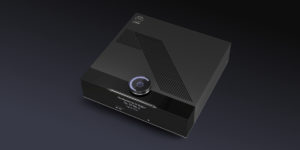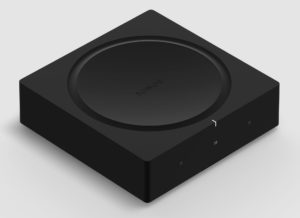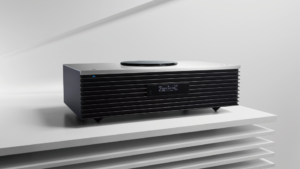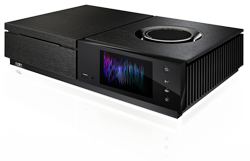 Linn recently gave birth to a new network streamer, the Selekt DSM. In these days they are launching the streamer across the world, showing all four versions to the public. Common to the Selekt DSM is the streaming. Two with or without the Katalyst precision DAC and either with or without integrated 100W Class-D amplifier. Now is your chance to hear all four perched against each other. A treat to be reckoned with…
Linn recently gave birth to a new network streamer, the Selekt DSM. In these days they are launching the streamer across the world, showing all four versions to the public. Common to the Selekt DSM is the streaming. Two with or without the Katalyst precision DAC and either with or without integrated 100W Class-D amplifier. Now is your chance to hear all four perched against each other. A treat to be reckoned with…
media|STREAMERS
The market for media hubs is difficult to navigate – I try to chart some waters here
Author Archives: Thomas Nielsen
Linn Selekt Ready To Launch
Sonos Amp Is A Grown Up Sonos
![]()
![]()
![]()
![]()
![]()
![]()
 Sonos released the Sonos Amp not long ago in what seems a simple replacement of the Connect Amp. There is, however, more to this than just a beefed up amplifier and streaming an input signal (and hopefully a better sound quality). In addition to those 125 watts of power, Sonos Amp will work with other Amp on your network and turn into an amalgamated surround system and/or in-ceiling sound system; and with that a small hardware twist. With the existing Connect Amp you could make a rack stack and feed your house through speaker cables, albeit at the risk of overheating. This new Amp has a much improved heatsink construction with one specific objective: to make life simple for builders of hidden sound systems. Despite a lot of unfortunate shenanigans, Sonos have proved to be, in fact, rather professional at heart.
Sonos released the Sonos Amp not long ago in what seems a simple replacement of the Connect Amp. There is, however, more to this than just a beefed up amplifier and streaming an input signal (and hopefully a better sound quality). In addition to those 125 watts of power, Sonos Amp will work with other Amp on your network and turn into an amalgamated surround system and/or in-ceiling sound system; and with that a small hardware twist. With the existing Connect Amp you could make a rack stack and feed your house through speaker cables, albeit at the risk of overheating. This new Amp has a much improved heatsink construction with one specific objective: to make life simple for builders of hidden sound systems. Despite a lot of unfortunate shenanigans, Sonos have proved to be, in fact, rather professional at heart.
Sonos Pruning Customers Once More
Sonos has announced that they are drawing another line in the sand for supported operating systems. This means that devices that cannot – or may not – be updated to their new minimum list will be unable to control Sonos. The devices affected are these:
Mobile Phones and Tablets
- Android below 4.3
- iOS below 9
- Amazon Fire OS below 4.1.1
Desktop Computers
- iOS below 10.10
- Windows below 7
Sonos have compiled a list of popular devices that did not originally ship with OS versions meeting this list but very elegantly avoid mentioning which of those devices cannot be updated to meet the new demands. While the iOS update doesn’t leave that many devices hanging, except perhaps a notable iPhone 4, the Android demands may prove to be a lot more troublesome.
Technics Ottava Goes Atomic
![]()
![]()
![]()
![]()
![]()
![]()
 The Technics Ottava series introduced 1½ years ago has gotten an atomic sibling, the SC-C70 or more poetically Ottava f, that sits on your shelf and plays all by itself. At an alluring price half the Naim MuSo it looks mighty tempting from that perspective alone. Stacking a CD transport on top of that makes it that much more interesting right there.
The Technics Ottava series introduced 1½ years ago has gotten an atomic sibling, the SC-C70 or more poetically Ottava f, that sits on your shelf and plays all by itself. At an alluring price half the Naim MuSo it looks mighty tempting from that perspective alone. Stacking a CD transport on top of that makes it that much more interesting right there.
Big sister SC-C500 received some mixed reviews, mostly targeting a less than optimum price-quality ratio. This time that ratio appears to be more inline with expectations in its price range. The all-in-one unit packs a 100W amp feeding 2x30W to the stereo front and 40W to the sub woofer, which all things considered, is very small. On the input side it plays not only CDs but also hi-res audio files in pretty much every conceivable format. What it does not, however, is support multi room synchronicity which could prove to be a suicide omission.
Ecosystems And Switching Costs
When you reach a certain level in hi-fi or, as it is the case in particular with multi room systems, you are bound by a high level of inter equipment compatibility, your investment is certain to be substantial. This is not really new. What is new, however, is a coupling with so-called digital ecosystems that is so tight that it very quickly becomes a problem.
Let’s for the sake of argument take a house with 5 rooms, or more in line with the zone-term, areas where you listen to music. If some of these areas conjoin or overlap, you need devices in those areas to be in perfect synch. This de facto means that they need to be of the same brand and model family. In areas further from each other, where sound is not likely to spill across, this is less important but still we have come to enjoy a certain level of remoteness; the ability to turn off the bedroom music while cooking in the kitchen. This does not require the same level of compatibility but it does require the devices to abide by the same protocols which pretty much means either the same brand or DLNA conformance. Very few audio systems are strictly DLNA. Most have features that are not specified in the standard or features that the vendor feel should operate differently and are distanced from existing standards.
There are two levels of ecosystems at play here. First there are the compatibility matrix formed by the devices themselves. Very few devices can operate optimally in a mixed environment. A Bluesound cannot tell a Marantz amplifier to power on or switch input, just like a Technics amplifier cannot tell a Sonos system to pause a queue or switch off the Play:5 in the bedroom. The devices are blissfully unaware of each other and as thick as a Jethro Tull record. Surely this is not a catastrophe but it certainly is inconvenient. This means that, out of convenience, we tend to bind ourselves to one ecosystem and by that put our proverbial eggs in one basket. The day Simple Audio was shut down they left their community with entire sound systems starting a death roll. And the thing is that the eggs in this modern basket are much more fragile than, say, a turntable. When the ecosystem dies, the product effectively degrades and ultimately turns to dust. If our 5 rooms had 5 different brands of devices and one brand kicks the bucket or removes an indispensable feature, you can remove that one device at a reasonable loss instead of having to replace the entire system at a considerable cost.
Another ecosystem domain to reckon with these days is the controller operating system. Consider again our fantasy system. Let’s equip our 5 rooms with the same brand of audio streamer and sprinkle in a few extras; some amps and a TV. The amplifier and TV run DLNA for which there are an abundance of more or less reliable apps for iOS, Android, Mac and Windows. The streamers have their own app, which is not available for one of the phone OSes and is incredibly slow on another, excluding two controller types. Unfortunately it is one one of these excluded phones that we find the best DLNA client. Suddenly we find ourselves using two different controllers plus an abundance of old fashioned remote controls. Then one day the OS on our preferred controller device gets a change in conditions preventing the DLNA app from running. The conflicts are legio. I am not mentioning any names. Suffice it to say that this is not entirely grabbed from thin air.
Both ecosystems have a very short life span. It is really quite incredible that nobody protests. I can understand that companies producing equipment are reluctant, unilaterally making their devices compatible with the competition but that doesn’t discount the fact that consumers are the ones carrying the loss here. And to make matters worse, a whole new ecosystem is on its way into the game. Home automation. Very few hi-fi devices allow themselves to be operated from home automation systems. Most that do are only working due to tenacious communities dissecting the protocols used. Not because companies divulge the information freely or comply with available standards. Logitech, or more accurately Slim Devices, tried when they open sourced their Squeezebox software. An open and active ecosystem disregarding the original devices left more or less in a limbo state without software updates.
As with the ability to remotely control devices from afar, we have come to enjoy the pervasive experience audio in every room gives us. The days of yore where we had a stereo in the living room and a transistor radio in the kitchen are long gone. The demand in quality in ambient sound has become increased for most music consumers, while strangely the opposite is true for the central stereo. The main device has become less important. For a great many people even less capable than household stereos were 25 years ago. More people have relatively good ambient sound while very few have barely adequate detail listening devices. High-end audio is probably on the same level as always, and equally frowned upon. But that is a topic for another article.
Naim Uniti in Flow Over From Mu-So
![]()
![]()
![]()
![]()
![]()
![]()
 When Naim released the Mu-So product line, they had the audiophiles pretty much convinced that multi-room audio could be done the autonomous-speaker-way hitherto personified by Sonos, without the transistor-radio-sonority personified by not only Sonos but their competitors as well, was actually feasible. Now they have brought some of the design decisions from Mu-So over to the Uniti line of products and, by the looks of it, become a serious contestant of the Linn throne. Even the Mu-So button has spawned.
When Naim released the Mu-So product line, they had the audiophiles pretty much convinced that multi-room audio could be done the autonomous-speaker-way hitherto personified by Sonos, without the transistor-radio-sonority personified by not only Sonos but their competitors as well, was actually feasible. Now they have brought some of the design decisions from Mu-So over to the Uniti line of products and, by the looks of it, become a serious contestant of the Linn throne. Even the Mu-So button has spawned.
The new Uniti comes in four flavors. The Atom, Star and Nova on the front end of things and the Core at the back. The Atom, Star and Nova are streamers with rudimentary external storage options with a capacity of 20,000 tracks and a 40W, 70W and 80W amplifier respectively. The Star and the Core have built-in CD transport and accompanying ripping facilities. The Core has an internal storage of up to 8TB and room for 100,000 tracks. Whether more Uniti Core units can be addressed simultaneously remains unknown at this point. After all, 100,000 tracks is only 5-6000 CDs.
The new Uniti devices are compatible with the the existing Uniti range.
Audio Stream Offers Extensive Computer Audio 101
Digital audio specialists Audio Stream are offering an easy to grasp insight into computer audio with their new article series Computer Audio 101. The articles span most issues one might have without getting overly detailed or nerdy.
Bowers & Wilkins In a Fibrillating Fairy Tale Sale

Sonos is Shrinking, Hopefully Not Shrivelling
In a blog post today, Sonos CEO john Macfarlane says that Sonos will be laying off an unspecified number of employees in a strategic move towards streaming rather than locally stored music. Staff reduction is serious enough in and of itself but the move they make towards streaming music may well be a serious blow to certain parts of the user base, namely those who listen to classical music and those who have many rare recordings. Try and find Eric Burdon’s Last Drive on a streaming service or even one of Solti’s Ring Cycle recordings. Sonos has always been problematic when playing back classical music, or any compound pieces for that matter, following this strategy things are not exactly looking like it will change. So, will we be seeing Sonos turning into a voice controlled transistor radio? I hope not but it certainly does look awfully lot like it will. The fact that Mr. Macfarlane refers to what we must assume are those who support local media as “laggards” doesn’t exactly help.
A Star Extinguished
 A star burned out today. Perhaps not the one shining the brightest but arguably the firmamentally most prominent of stars. A man of artistic integrity to the point where it almost broke him followed by a restored artist balancing arts with the personal integrity he then lacked. Eventually the mark he left on the world is unequivocal and his latest album a worthy swansong, as it so tragically turns out. It would have been just like him to do that deliberately, wouldn’t it?
A star burned out today. Perhaps not the one shining the brightest but arguably the firmamentally most prominent of stars. A man of artistic integrity to the point where it almost broke him followed by a restored artist balancing arts with the personal integrity he then lacked. Eventually the mark he left on the world is unequivocal and his latest album a worthy swansong, as it so tragically turns out. It would have been just like him to do that deliberately, wouldn’t it?
Copyright © 2025. Powered by WordPress & Romangie Theme.